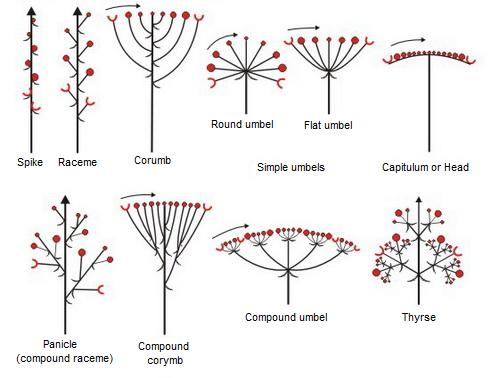|

Flowers may be solitary, or they may be grouped together in an inflorescence, a cluster of flowers. An inflorescence has one main stalk, or peduncle. It mayalso bear numerous smaller stalks called pedicels, each with a flower at its tip. The arrangement of pedicels on a peduncle characterizes different kinds of inflorescences. Some of the common types of inflorescences are as follows:
Spike: The flowers, which are with a very short or with no pedicel, are attached along the elongate and unbranched peduncle of the inflorescence (examples: plantain, spearmint, tamarisk).
Raceme: The flowers are with pedicels of about the same length, which are attached along the elongate and unbranched peduncle of the inflorescence (examples: lily of the valley, snapdragon, mustard, currant). The oldest flowers are at the base of the inflorescence and the youngest at the apex.
Panicle: The flowers are with pedicels, which are attached along the branches arising from the peduncle of the inflorescence (examples: oats, rice, fescue).
Corymb: The flowers are with pedicels of unequal length, which are attached along an unbranched, elongate peduncle, forming a flattopped inflorescence (examples: hawthorne, apple, dogwood).
Umbel: The flowers are with pedicles, which are all attached at about the same point at the end of the peduncle this is specifically called a simple umbel (examples: onion, geranium, milkweed). A compound umbelis formed when the peduncle produces branches that end at approximately the same level, forming a flat top, and the ends of these branches arise from a common point (examples: carrot, dill, parsley).
Head: The flowers do not have pedicels, and they all cluster tightly on the expanded tip of the peduncle (examples: sunflower, daisy, marigold). This type of inflorescence is also referred to as capitulum.
Cyme: The flowers with pedicels are located at the ends of the peduncle and lateral branches as well as along the length of the lateral branches. The youngest flowers in any cluster occur farthest from the tip of the peduncle (example: chickweed).
Catkin:The flowers have no pedicels, are unisexual (either staminate or pistillate), and are at tached along the length of the peduncle (examples: hazelnut, willow, birch, walnut). The flowers are usually very small and fall as a group. This type of inflorescence is also referred to as ament.
Spadix: The flowers have no pedicels and are attached along the length of the thickened or fleshy peduncle, which is enveloped by a conspicuously colored bract called a spathe (example: philodendron, anthurium).
Some types of inflorescences characterize different groups of plants. For example, nearly all members of the carrot family (Apiaceae) have compound umbels. All members of the sunflower family (Asteraceae) have heads, including chrysanthemums, zinnias, marigolds, and dandelions. All members of the arum family (Araceae) have a spadix inflorescence.
|
